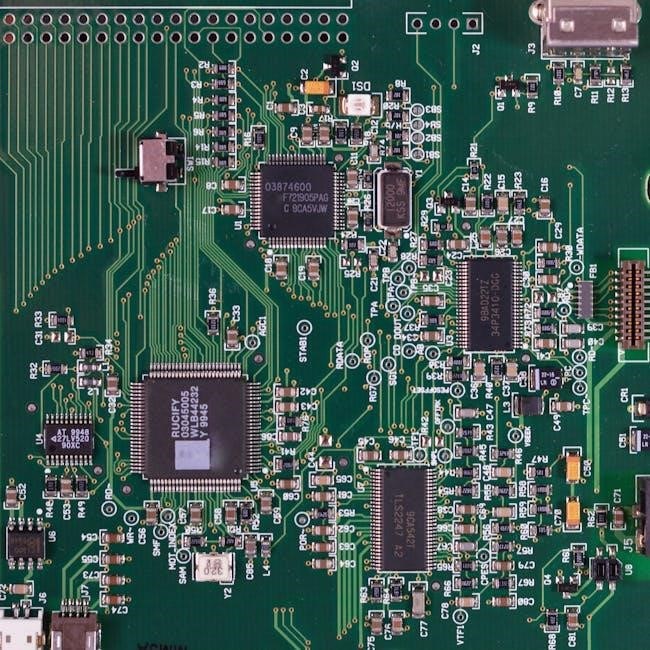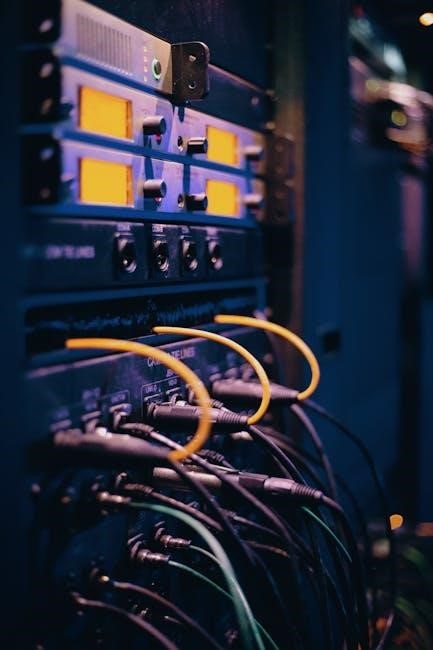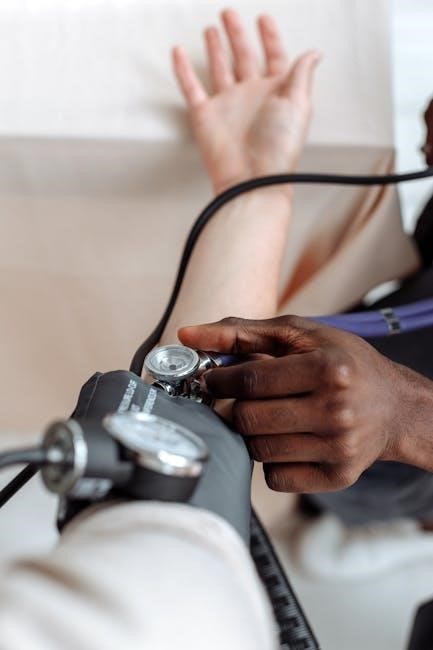The cardiovascular system is a vital network responsible for transporting oxygen, nutrients, and hormones throughout the body. It consists of the heart, blood vessels, and blood.
This system plays a crucial role in maintaining homeostasis and overall health by ensuring proper circulation and nutrient delivery to tissues, essential for survival and bodily functions.
1.1 Definition and Overview
The cardiovascular system, also known as the circulatory system, is a complex network designed to transport blood throughout the body. It consists of the heart, blood vessels, and blood, functioning as the primary means of delivering oxygen, nutrients, and hormones to cells while removing waste products. This system is essential for maintaining homeostasis and supporting the body’s metabolic processes. Its intricate design ensures efficient circulation, enabling proper bodily functions and overall health.
1.2 Importance of the Cardiovascular System
The cardiovascular system is crucial for sustaining life by delivering oxygen and nutrients to cells while removing waste products. It supports immune function, hormone distribution, and regulates body temperature. Without it, tissues would lack essential supplies, leading to cellular dysfunction and organ failure. Its efficiency ensures proper bodily functions, making it vital for overall health and survival.

Structure of the Cardiovascular System
The cardiovascular system comprises the heart, blood vessels, and blood. It includes arteries, veins, and capillaries, forming a network for blood circulation, essential for oxygen and nutrient delivery.
2.1 Heart Anatomy
The heart is a muscular organ roughly the size of a fist, weighing less than a pound. It consists of four chambers: two atria and two ventricles, separated by a septum. The septum divides the heart longitudinally, preventing the mixing of oxygen-rich and oxygen-poor blood. The heart’s walls are composed of three layers: the epicardium (outer layer), myocardium (muscular middle layer), and endocardium (inner layer). This structure ensures efficient pumping and circulation of blood throughout the body.
2.2 Blood Vessels: Arteries, Veins, and Capillaries
Arteries, veins, and capillaries form the vascular network of the cardiovascular system. Arteries carry oxygen-rich blood away from the heart, while veins return oxygen-poor blood to it. Capillaries, the smallest vessels, enable the exchange of nutrients, oxygen, and waste products between blood and tissues. Arteries have thick walls to withstand high pressure, whereas veins have one-way valves to prevent backflow. Capillaries are thin-walled, facilitating diffusion. Together, they ensure efficient circulation and maintain overall bodily functions.
2.3 Septum and Chambers of the Heart
The heart is divided by a septum into four chambers: two atria and two ventricles. The interatrial septum separates the right and left atria, while the interventricular septum divides the ventricles. These chambers work together to ensure blood flows in the correct direction. The septum prevents mixing of oxygen-rich and oxygen-poor blood, maintaining efficient circulation. This structural separation is crucial for the heart’s function in pumping blood to the lungs and the rest of the body, ensuring proper oxygenation and nutrient delivery.

Function of the Cardiovascular System
The cardiovascular system performs vital functions, including transporting oxygen and nutrients to cells, regulating blood pressure, and facilitating waste removal. It ensures proper circulation and supports overall health.
3.1 Transportation of Oxygen and Nutrients
The cardiovascular system efficiently transports oxygen and nutrients throughout the body. Oxygen from the lungs binds to red blood cells and is distributed via arteries. Nutrients absorbed in the small intestine enter the bloodstream, reaching cells through capillaries. This process ensures proper cellular function and energy production, vital for maintaining overall health.
3.2 Regulation of Blood Pressure and Flow
The cardiovascular system regulates blood pressure and flow through a complex interplay of neural and hormonal mechanisms. The autonomic nervous system, including sympathetic and parasympathetic branches, adjusts heart rate and vessel diameter. Hormones like aldosterone and angiotensin II also play key roles in maintaining blood pressure by controlling fluid balance. Baroreceptors in blood vessels detect pressure changes and trigger reflexes to restore balance. This regulation ensures adequate blood flow to meet the body’s metabolic needs while preventing damage from excessive pressure.

Blood Circulation
Blood circulation involves the movement of blood through the heart and blood vessels, supplying oxygen and nutrients to tissues while removing waste products.
4.1 Pulmonary Circulation

Pulmonary circulation is the pathway by which deoxygenated blood flows from the heart to the lungs and returns oxygenated. It begins when the right ventricle pumps blood through the pulmonary artery to the lungs. In the lungs, blood picks up oxygen and releases carbon dioxide through capillary exchange. The oxygen-rich blood then returns to the left atrium via the pulmonary veins, completing the cycle. This process is essential for gas exchange and maintaining proper oxygen levels in the body.

4.2 Systemic Circulation
Systemic circulation transports oxygenated blood from the heart to the body and returns deoxygenated blood. It begins with the left ventricle pumping blood through the aorta, the largest artery, to various tissues. Arteries branch into smaller arterioles and capillaries, allowing oxygen and nutrients to diffuse into cells. Deoxygenated blood collects in venules and veins, returning to the right atrium. This circuit ensures oxygen delivery and waste removal, maintaining cellular function and overall health throughout the body.

Blood Vessel Network
The blood vessel network is an intricate system of arteries, veins, and capillaries, ensuring efficient circulation of blood throughout the body.
5.1 Arterial System
The arterial system is a network of vessels that carry oxygen-rich blood away from the heart to the rest of the body. Arteries are thick-walled, muscular tubes designed to withstand high blood pressure generated by the heart’s contractions. They branch into smaller arterioles, which regulate blood flow to specific tissues. Elastic arteries, like the aorta, stretch to accommodate blood ejected during systole, while muscular arteries control peripheral resistance and blood distribution. The arterial system is crucial for delivering oxygenated blood efficiently throughout the body.
5.2 Venous System
The venous system consists of veins that return deoxygenated blood to the heart. Veins are less muscular than arteries, with one-way valves preventing backflow. They operate under lower pressure, relying on muscle contractions and gravity for blood return. The venous system includes superficial veins near the skin and deep veins surrounded by muscles. It ensures efficient blood circulation, maintaining proper blood distribution and overall cardiovascular health by returning blood to the heart for re-oxygenation and recirculation. This system is vital for sustaining the body’s metabolic needs.
5.3 Capillary Function
Capillaries are tiny, thin-walled blood vessels that enable the exchange of oxygen, nutrients, and waste products between blood and tissues. They connect arterioles to venules, forming a network for efficient diffusion. Capillaries allow oxygen and nutrients to diffuse into tissues while absorbing carbon dioxide and waste. Their single-layered endothelial structure facilitates this exchange. Capillary function is crucial for delivering oxygen to cells and maintaining proper tissue function, ensuring overall health and metabolic balance throughout the body.

Heart Physiology
The heartbeat is the contraction of the heart muscle to pump blood throughout the body, regulated by its internal electrical system to maintain a consistent rhythm.
6.1 Cardiac Cycle and Heartbeat
The cardiac cycle refers to the sequence of events in the heart from the start of one heartbeat to the beginning of the next. It includes systole, when the heart muscle contracts, and diastole, when it relaxes. The heartbeat is initiated by electrical impulses from the sinoatrial node, the heart’s natural pacemaker, ensuring a rhythmic and coordinated pumping action to circulate blood efficiently throughout the body.
6.2 Electrical Activity of the Heart
The electrical activity of the heart is controlled by a complex system that regulates the timing and rhythm of heartbeats. The sinoatrial node acts as the heart’s natural pacemaker, generating electrical impulses that trigger cardiac contractions. These impulses travel through the atrioventricular node and the bundle of His, ensuring coordinated contraction of the atria and ventricles. This electrical system maintains a consistent heartbeat, enabling efficient blood circulation and adapting to physiological demands, such as increased activity or stress.

Blood Composition
Blood is composed of plasma, red blood cells, white blood cells, and platelets, each serving unique roles in oxygen transport, immune defense, and clotting.
7.1 Plasma and Its Role
Plasma, the liquid portion of blood, makes up approximately 55% of its total content. It is primarily composed of water (about 92%), proteins, nutrients, hormones, gases, waste products, and clotting factors. Plasma serves as the medium for transporting cells, nutrients, and hormones throughout the body. It plays a critical role in maintaining blood pressure, regulating pH, and aiding in blood clotting. Additionally, plasma facilitates the exchange of materials between blood and tissues, ensuring proper cellular function and overall bodily homeostasis.
7.2 Red and White Blood Cells
Red blood cells (RBCs), or erythrocytes, are responsible for transporting oxygen throughout the body via hemoglobin. White blood cells (WBCs), or leukocytes, play a key role in the immune system by fighting infections and diseases. There are several types of WBCs, including neutrophils, lymphocytes, and monocytes, each with specific functions in immune defense. Both RBCs and WBCs are produced in the bone marrow and are essential for maintaining oxygenation and immunity. Their proper function is vital for overall health and bodily protection against pathogens.
7.3 Platelets and Blood Clotting
Platelets, or thrombocytes, are small, irregularly-shaped blood cells that play a critical role in blood clotting. When bleeding occurs, platelets aggregate to form a platelet plug, which temporarily seals the wound. This process is followed by the coagulation cascade, where clotting factors transform fibrinogen into fibrin, creating a stable blood clot. Platelets also release chemicals that attract more platelets and promote clot formation. Proper blood clotting is essential for preventing excessive blood loss, while disorders in this process can lead to bleeding or thrombosis, highlighting the importance of this mechanism in maintaining cardiovascular health.

Regulation Mechanisms
The cardiovascular system is regulated by the autonomic nervous system and hormones like adrenaline, ensuring blood pressure and flow are maintained according to the body’s needs.
8.1 Autonomic Nervous System
The autonomic nervous system (ANS) regulates cardiovascular functions through sympathetic and parasympathetic branches. The sympathetic system increases heart rate and blood pressure, preparing the body for stress.
The parasympathetic system promotes relaxation, slowing heart rate and reducing cardiac output. The ANS maintains cardiovascular homeostasis by adjusting these responses to physical and emotional demands, ensuring optimal blood flow and pressure.
8.2 Hormonal Regulation
Hormonal regulation plays a crucial role in managing cardiovascular functions. Hormones like aldosterone and atrial natriuretic peptide influence blood volume and sodium levels, affecting blood pressure. Additionally, antidiuretic hormone (ADH) regulates water retention, maintaining fluid balance. These hormones work in tandem with the autonomic nervous system to ensure proper cardiovascular homeostasis, adapting to changes in blood pressure and volume. Their balanced interaction is essential for maintaining optimal heart function and overall circulatory health.
The cardiovascular system is essential for delivering oxygen and nutrients, maintaining life. Proper heart function, blood vessel health, and circulation are vital for overall well-being and disease prevention.
9.1 Summary of Key Points
The cardiovascular system, comprising the heart, blood vessels, and blood, is vital for transporting oxygen, nutrients, and hormones. It regulates blood pressure and supports immune responses. The heart, a muscular organ, pumps blood through arteries, veins, and capillaries, enabling oxygen delivery to tissues. Proper circulation is crucial for survival, with pulmonary circulation oxygenating blood and systemic circulation supplying nutrients. The autonomic nervous system and hormones regulate heart function. Maintaining cardiovascular health is essential to prevent diseases and ensure optimal bodily functions.
9.2 Importance of Maintaining Cardiovascular Health
Maintaining cardiovascular health is crucial for preventing diseases like hypertension and heart failure. Regular physical activity, a balanced diet, avoiding smoking, and managing stress are essential. These practices promote healthy blood flow, regulate blood pressure, and enhance overall heart function, reducing the risk of cardiovascular disorders and ensuring long-term well-being.
